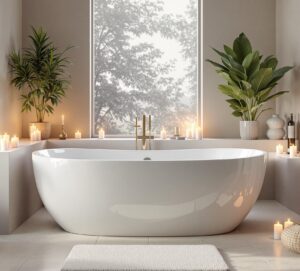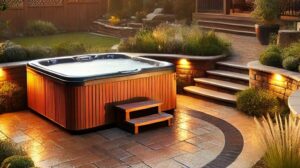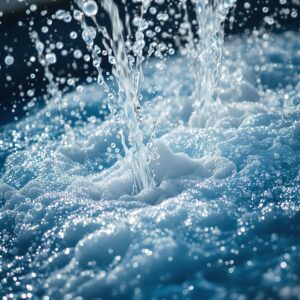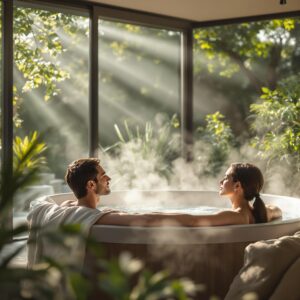Hot Tub vs Jetted Bathtub:
Which Is Better for Your Relaxation and Hydrotherapy Needs?
Discover the ultimate guide that breaks down every detail to help you choose between a hot tub and a jetted bathtub. In this post, you will learn the key differences, benefits, and trade-offs between these two hydrotherapy options.
Introduction
Imagine coming home after a long day and having a place to relax that fits your life perfectly. You might be drawn to a hot tub with its inviting outdoor charm and social vibe, or you may lean toward a jetted bathtub that gives you a private, spa-like experience right in your bathroom. Both options offer the benefits of warm water and soothing jets, but they are built for different lifestyles and needs.
This guide starts by explaining the basic ideas behind hot tubs and jetted bathtubs. You will learn about their design, installation, and how they work to relieve stress and muscle tension. The guide explains why these differences matter—whether you want to entertain friends or enjoy some quiet time on your own. We also cover the practical details like cost, maintenance, and energy use.
The post will take you step by step through several key topics:
- Main Topic Exploration: Understand how each option works, their benefits, and their drawbacks.
- Comparative Analysis: See side-by-side comparisons in tables that make the differences clear.
- Performance Factors: Learn which features matter most and why.
- Implementation Guide: Follow simple, numbered steps to plan your installation.
- Troubleshooting: Find easy fixes for common problems.
- Innovation & Extended Applications: Discover creative uses and future trends.
- Long-term Considerations: Think about sustainability and long-lasting value.
- Expert FAQ: Read answers to important questions from experts.
- Conclusion & Next Steps: Wrap up your learning and get tips for further research.
Each section is written in clear, simple language so that you can quickly grasp the essential points. By the end, you will know which option is best for you and how to get started on your journey to a more relaxed life.
Now, let’s dive into the details of hot tubs and jetted bathtubs and see which one suits your lifestyle best.


Main Topic Exploration
What Are Hot Tubs and Jetted Bathtubs?
Hot Tub:
- Design & Purpose: A hot tub is a large, self-contained unit often placed outdoors. It is designed for group use with multiple seating spots and powerful jets for a full-body massage.
- Usage: Ideal for social gatherings, deep muscle relaxation, and year-round hydrotherapy.
Jetted Bathtub:
- Design & Purpose: A jetted bathtub is built into your home’s bathroom. It combines a regular tub with built-in jets that target key muscle groups.
- Usage: Perfect for personal or couple use, offering a private, spa-like experience with lower energy use.
How They Work
Hot tubs use a dedicated heating system and pumps to keep water warm and to push water through numerous jets. This creates a massaging effect that covers the whole body. In contrast, jetted bathtubs rely on your home’s water supply and heat the water for one-time use. They have fewer jets, which provide gentle, focused massage.
Benefits and Drawbacks
-
Hot Tubs:
- Benefits:
- Full-body hydrotherapy
- Social use and entertainment
- Consistent water temperature
- Drawbacks:
- Higher cost and maintenance
- Need for outdoor space or special indoor setup
- Energy consumption can be high
- Benefits:
-
Jetted Bathtubs:
- Benefits:
- Easier to install in a bathroom
- Lower energy and maintenance costs
- Uses fresh water each session
- Drawbacks:
- Limited to one or two users
- Fewer jets and less intense massage
- Water cools quickly during use
- Benefits:
Custom Table 1: Feature Comparison
| Feature | Hot Tub | Jetted Bathtub |
|---|---|---|
| Capacity | 4-8+ people | 1-2 people |
| Installation | Outdoor/Indoor with special setup | Integrated into bathroom |
| Maintenance | High: Regular water treatment | Low: Drained after each use |
| Cost | High initial & operating costs | Lower initial & operating costs |
| Hydrotherapy | Full-body, powerful jets | Targeted, gentle jets |
Custom Table 2: Cost and Energy Overview
HTML Diagram: Key Concepts Interaction
“A hot tub is not just a luxury item—it is a hub for family relaxation and wellness.”
– Cleveland Clinic
“The jetted bathtub brings the spa experience into the privacy of your home with minimal fuss.”
– Home Depot
Comparative Analysis
When comparing a hot tub to a jetted bathtub, the choice depends on your lifestyle and needs. Let’s review the key criteria:
-
Size & Capacity:
- Hot Tub: Ideal for groups and outdoor use.
- Jetted Bathtub: Best for individual or couple use in a confined space.
-
Installation & Space Requirements:
- Hot Tub: Needs a special area, outdoor deck, or a dedicated indoor space with proper support.
- Jetted Bathtub: Fits within a standard bathroom, with easier plumbing integration.
-
Maintenance:
- Hot Tub: Requires ongoing chemical treatment and regular water changes.
- Jetted Bathtub: Uses fresh water each time, making maintenance simpler.
-
Cost & Energy Consumption:
- Hot Tub: Higher cost due to larger size and continuous heating.
- Jetted Bathtub: Lower cost and energy use because it heats only when in use.
-
Therapeutic Benefits:
- Hot Tub: Offers full-body hydrotherapy with customizable jets.
- Jetted Bathtub: Provides focused, gentler massage effects.
Summary Table with Color-Coding
Based on this analysis, if you seek a social, full-body spa experience and have the space and budget, a hot tub may be best. However, if you value simplicity, lower costs, and indoor convenience, a jetted bathtub might be the better choice.
Performance Factors
Key Performance Variables
-
Heating Efficiency:
Hot tubs use dedicated heaters that maintain water temperature, while jetted bathtubs rely on your home’s water heater. -
Jet Power:
Hot tubs feature more powerful, adjustable jets that deliver full-body massage. Jetted bathtubs provide a gentler massage that is enough for relaxation. -
Energy Consumption:
Continuous operation in hot tubs leads to higher energy use. In contrast, jetted bathtubs heat water only during use, lowering energy bills. -
Water Volume & Usage:
Hot tubs hold a large volume of water and recycle it over weeks. Jetted bathtubs use fresh water each session, affecting overall water consumption.
How They Interact
The key factors interact to determine your overall experience. For example, high jet power in hot tubs is linked to deeper muscle relief but requires more energy. In jetted bathtubs, the lower energy demand aligns with a lighter massage experience, which is perfect for quick relaxation.

Visual Representation
Actionable Strategy:
- Optimize your hot tub’s energy use by using an insulated cover.
- In a jetted bathtub, consider pre-heating water to improve comfort.
Implementation Guide
Step-by-Step Setup for Your Hydrotherapy Option
-
Assess Your Space:
- Measure the available outdoor area for a hot tub or check your bathroom layout for a jetted bathtub.
- Ensure you have proper access to electrical outlets and plumbing.
-
Set Your Budget:
- Factor in the purchase cost, installation fees, and future maintenance.
- Compare your budget with the typical ranges: Hot tubs ($3,000–$20,000+) vs. Jetted Bathtubs ($1,000–$10,000+).
-
Choose Your Model:
- Visit showrooms or check online reviews.
- Look for models with energy-saving features and customizable jets.
-
Plan Installation:
- For a hot tub, prepare a level, reinforced surface like a concrete pad or deck.
- For a jetted bathtub, schedule a consultation with a plumber for any necessary bathroom modifications.
-
Set Up Utilities:
- Arrange for a licensed electrician to handle the hot tub’s electrical needs (often 220V).
- Verify that your home’s water supply and drainage are adequate for a jetted bathtub.
-
Maintenance Preparation:
- Purchase cleaning supplies, chemicals for hot tubs, and jet cleaners for bathtubs.
- Create a schedule for routine water testing and cleaning.
-
Follow Safety Guidelines:
- Install handrails if needed.
- Ensure that all installations meet local building and safety codes.
-
Test Run:
- Fill the unit, test all controls, and run the jets.
- Check for leaks or malfunctions before regular use.
Expert Tip:
Regularly inspect the jets and filters. Small issues can turn into larger problems if ignored.
“Careful planning during installation is key to long-term satisfaction and safe use.”
– This Old House
Troubleshooting Common Issues
Quick Fixes and Diagnostic Steps
-
Temperature Drop:
- Problem: Water cools quickly during use.
- Solution: Check your insulation and cover. Make sure the heater is working properly.
-
Weak Jets:
- Problem: Jets are not producing enough pressure.
- Solution: Clean or replace filters and clear any blockages in the jet system.
-
Unusual Noises:
- Problem: Excessive noise from pumps or jets.
- Solution: Tighten loose fittings, inspect the motor, and schedule professional maintenance if needed.
-
Water Quality Issues:
- Problem: Cloudy water or skin irritation.
- Solution: Test water chemistry in hot tubs; for jetted bathtubs, ensure a thorough clean after each use.
Troubleshooting Steps
- Step 1: Isolate the problem by checking one component at a time (heater, pump, filters).
- Step 2: Follow the manufacturer’s guidelines for cleaning and maintenance.
- Step 3: If the issue persists, contact a professional technician.
Expert Insight:
Regular maintenance can prevent many of these issues. Keeping a log of service dates and repairs is a smart practice.
Innovation and Extended Applications
New Trends and Creative Uses
Innovation in hydrotherapy is evolving. Many homeowners now integrate smart controls into hot tubs and jetted bathtubs, allowing you to adjust temperature and jet settings via your smartphone. This technology not only adds convenience but can also help save energy.
Emerging Trends:
- Smart Technology: Automated systems that monitor water quality and energy use.
- Eco-Friendly Designs: Energy-efficient heaters and water recycling features.
- Multi-Functionality: Units that double as outdoor furniture or modern bathroom fixtures.
Creative Adaptations:
- Transforming a hot tub area into an outdoor lounge with integrated lighting and sound.
- Using a jetted bathtub as a centerpiece in a luxury home spa room.
Future Developments
Experts foresee that new materials and technologies will make both hot tubs and jetted bathtubs more energy-efficient and easier to maintain. Innovations may include self-cleaning systems and customizable jet programs tailored to your health needs.
“The future of home hydrotherapy lies in integrating comfort with technology.”
– Jacuzzi Expert Review
These advancements will likely blur the lines between traditional hot tubs and jetted bathtubs, offering a wider range of features to suit every lifestyle.
Long-term Considerations
Sustainability and Maintenance Over Time
When planning your investment, consider the long-term care and impact on your home. Hot tubs, while offering intense hydrotherapy, require regular maintenance and can use more energy. They are a big investment, but if well cared for, they can last 10-20 years. Jetted bathtubs typically have a lifespan of 10-15 years and are easier to maintain.
Cost-Benefit Analysis
- Hot Tub: Higher initial and maintenance costs but may boost outdoor living appeal.
- Jetted Bathtub: Lower costs and easier upkeep, with a strong resale value as a luxury bathroom feature.
Long-term, it is wise to factor in energy bills, upkeep, and replacement parts. Choose the option that best aligns with your lifestyle and maintenance commitment.
Expert FAQ Section
Q1: Which option is more energy-efficient?
A1: Jetted bathtubs are more energy-efficient since they heat only the water needed for each session, while hot tubs require continuous heating.
Q2: What is the typical lifespan of these units?
A2: Hot tubs last about 10-20 years with proper care, whereas jetted bathtubs generally last 10-15 years.
Q3: How does maintenance differ?
A3: Hot tubs need regular water treatment and cleaning due to large water volume. Jetted bathtubs are simpler because they use fresh water for every use.
Q4: Can these units improve my health?
A4: Yes, both offer hydrotherapy benefits such as muscle relaxation, improved circulation, and stress relief. Hot tubs deliver stronger massage effects, while jetted bathtubs provide targeted relief.
Q5: What about installation complexity?
A5: Hot tubs often require professional installation and a dedicated space, whereas jetted bathtubs can be integrated into an existing bathroom.
Q6: Is there a significant cost difference?
A6: Hot tubs are generally more expensive in both purchase and operation, while jetted bathtubs are more budget-friendly overall.
Q7: Which option fits best with a busy lifestyle?
A7: If you prefer a low-maintenance and private experience, a jetted bathtub is ideal. For those who enjoy social relaxation and robust hydrotherapy, a hot tub is worth the extra effort.
Conclusion
In this guide, we explored every detail of hot tubs and jetted bathtubs. You learned that hot tubs are great for social settings and deep hydrotherapy, while jetted bathtubs offer a private, cost-effective solution with low maintenance. Both have unique strengths and weaknesses.
By assessing your space, budget, and lifestyle, you can choose the option that best meets your needs. Whether you opt for a hot tub or a jetted bathtub, the benefits of hydrotherapy are clear: improved relaxation, better muscle recovery, and a boost in overall well-being.
Take the next step by visiting a local showroom or consulting with a professional installer. Your perfect home spa experience is just a decision away
Additional Resources
- Cleveland Clinic: Benefits of Hydrotherapy
- Home Depot: Hot Tub Installation Tips
- This Old House: Guide to Bathroom Upgrades
- Jacuzzi: Innovations in Hydrotherapy
- Angi: Cost Comparison of Home Spa Solutions
Technical Glossary
- Acrylic: A durable plastic used in tub construction.
- Buoyancy: The upward force that water exerts on a body immersed in it.
- Filtration: The process of removing impurities from water.
- GFCI: Ground Fault Circuit Interrupter; a safety device for electrical outlets.
- Hydrotherapy: The use of water for pain relief and treatment.
- Insulation: Material that reduces heat loss.
- Plumbing: The system of pipes and fixtures in a building.
- Recirculation: The continuous movement of water through a system.
- Thermostat: A device that regulates temperature.
- Ventilation: The process of exchanging or replacing air in a space.
We hope this guide has given you a clear, step-by-step look at the differences between hot tubs and jetted bathtubs. Your next step is to consider which option fits your lifestyle and to explore further with the recommended calculator. Enjoy your journey to a more relaxed and healthy home spa experience!
Would you like to learn more about specific installation tips or further cost breakdowns? Your feedback is welcome!

